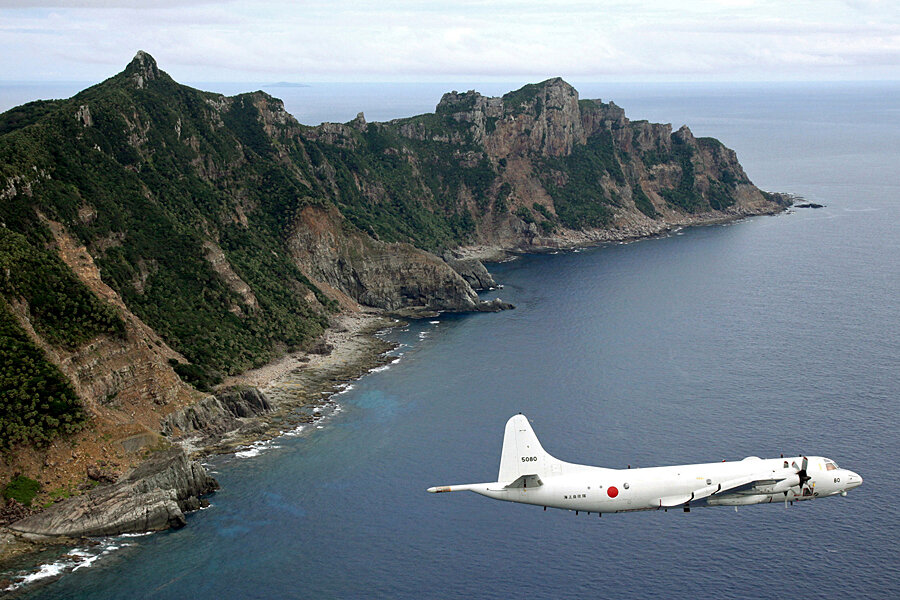Behind Japan's new military plans: China, nationalism, or both?
Loading...
| Tokyo
Japan's approval of new national defense guidelines and its first-ever national security strategy are raising questions whether, after a year of focusing on the economy, Prime Minister Shinzo Abe is finally baring his nationalist teeth.
The announcement this week of a significant increase in military spending over the next five years to counter China’s growing military influence in the region was not unexpected. Mr. Abe insisted it did not signal a departure from the country's longstanding postwar pacifism or the strictly defensive role of its armed forces. Japan's annual defense budget rose for the first time in 11 years this year, albeit by a meager 0.8 percent.
Jun Okumura, a visiting scholar at the Meiji Institute for Global Affairs in Tokyo, described Japan’s hike in military spending as “a real turnaround, but still way behind what we can expect from China in the foreseeable future.
“Is Japan becoming a ‘normal’ country? Well, it still won’t have nuclear weapons, ballistic or cruise missiles, strategic bombers, aircraft carriers, and the other normal trappings of a superstate … so [China's] People’s Liberation Army can sleep easy,” he says.
Others are more alarmed by the defense guidelines, unveiled Tuesday.
“It’s true that this is in part a reaction to the different security threats Japan faces today compared with the good old days of the Cold War, but it would be naive to see these new defense measures as a purely technocratic response to what’s happening in the region,” says Koichi Nakano, a professor of international politics at Sophia University in Tokyo.
China looms large
The documents leave little doubt that China's recent actions are underlying Tokyo’s plans to bolster its military. They contain unambiguous references to Chinese naval and aerial activity near the Senkaku – a group of islands in the East China Sea administered by Japan but also claimed by China, where they are known as the Diaoyu – and its recent imposition of an air defense identification zone in the area.
For more on China's latest move, read: China's aggressive air zone rattles a suspicious region
"China is attempting to change the status quo by force in the skies and seas of the East China Sea and South China Sea and other areas, based on its own assertions, which are incompatible with the established international order," the national security strategy said. "China's stance toward other countries and military moves, coupled with a lack of transparency regarding its military and national security policies, represent a concern to Japan and the wider international community and require close watch."
Japan’s military inventory, to be expanded over the next five years, will include three unmanned drones, 28 F-35A fighters, 17 Osprey aircraft, and five naval destroyers, including two with Aegis antiballistic-missile systems. The guidelines include an additional six submarines, taking its total to 22.
Japan, the world’s sixth-biggest military spender for the past two decades, will set aside 23.97 trillion yen (US$232.4 billion) to fund the expansion, up from 23.37 trillion yen from the previous five years.
No ability to strike overseas
The guidelines stop short of developing the ability to strike enemy targets overseas – a controversial move that sits uneasily with Japan's postwar "pacifist" Constitution and which would set alarm bells ringing in the US, as well as in northeast Asia. There was no mention, either, of Abe's long-cherished goal of revising the Constitution to allow the military to play a more active role overseas.
In making frequent references to China, Japan’s defense plans are in tune with public sentiment. In a poll conducted last summer by the Japanese think-tank Genron, 90 percent of Japanese respondents said they had a negative impression of China; half of people with that view cited the Senkaku/Diaoyu island dispute. More than 60 percent of the total identified China as a military threat.
US response
The US welcomed Abe’s commitment to what he calls “proactive pacifism.” Speaking during a recent visit to the Philippines, US Secretary of State John Kerry played down fears that Japan’s increased military spending could become a further source of instability.
“This is not a sudden response to something or anything that anybody should be upset about,” Mr. Kerry said. “Japan has the ability to play a more modern, engaged role. This is something we have been working on, and they have been planning for some period of time.”
An official at the prime minister’s office said the increase in military spending merely demonstrated Abe’s desire to “join the club of democratic, like-minded allies from which it has benefited from for so long.”
The official who, spoke to the Monitor on condition of anonymity, agreed that the plans could upset Beijing.
“I’m sure Beijing is angry about Japan’s posture, but so be it,” he said. “Although Japan’s defense spending has increased, it is still in the area of 1 percent of nominal GDP. I’d be worried if it had risen to, say, 5 percent, but in fact this is only a tiny increase."
He conceded that diplomatic ties with China and South Korea were likely to remain strained for the time being: Abe has not held official talks with his counterparts in Beijing and Seoul since becoming prime minister a year ago.
“China is pushing the envelope every day so it’s difficult for Japan to make overtures any time soon,” he said of China's frequent incursions into waters around the Senkakus and its recent imposition of the air-defense zone.
Some observers remain concerned about what they see as a broader Abe agenda.
Added to moves to push patriotic education in schools and the recent introduction of a controversial state secrets law, the defense buildup is evidence of a more “authoritarian and revisionist” trend inside the Abe administration, Mr. Nakano says.
Anxiety over Japan’s military plans is not confined to China and South Korea, he says.
“Some in the US administration are happy to see Japan play a wider military role, but there is another group that is worried about Japanese nationalistic tendencies that could put the US on a collision course with China,” he said.
The official at the prime minister’s office said poor public relations were partly to blame for frequent descriptions of Abe as a nationalist bent on remilitarizing Japan.
“There is a PR deficit on the part of the Japanese,” he said. “Looking at the headlines, that perception is very persistent. But I’m not that bothered by it, and I don’t think Abe is, either.”








